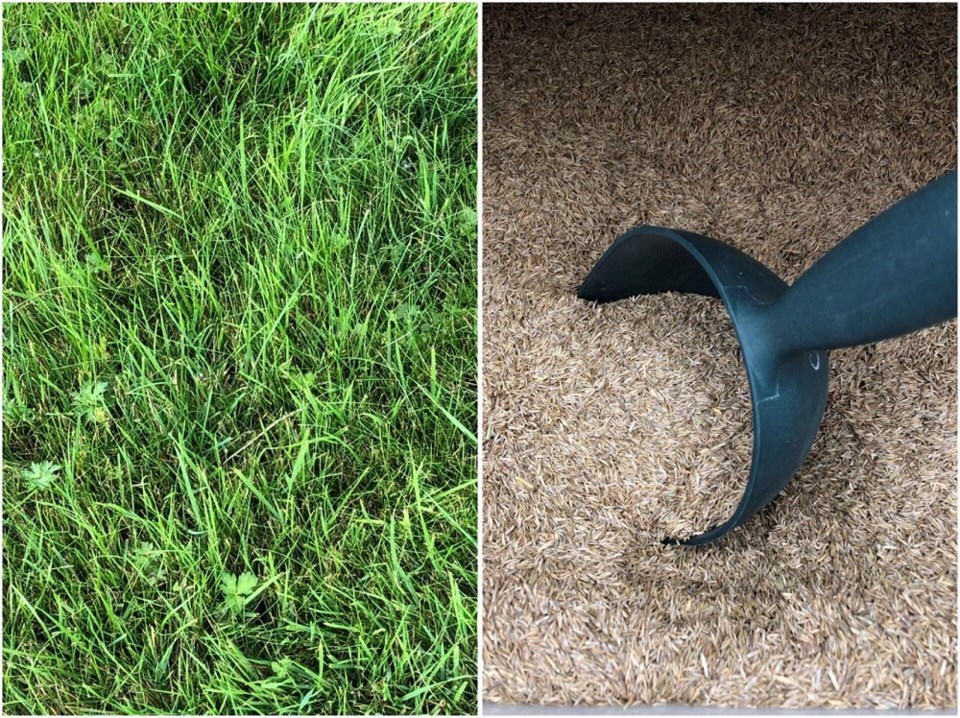Based on all the questions I have been asked over the past few weeks, it is clear there is some confusion over the various steps that need to be taken each year to ensure healthy lawns.
The first step is moss control. Moss thrives in shady areas with acidic soil, poor drainage and low fertility.
You can’t usually do much about the shade, but spreading lime, which will not eliminate the moss but rather correct the acidic soil condition by raising the pH level, thus allowing grasses to pick up more existing nutrients in the soil. The easy-to-apply ‘Dolopril’ coated lime contains magnesium as well, and releases quickly to raise the pH level in spring. A 10 kg. bag covers about 2,000 square feet (200 sq. meters).
Poor drainage is the primary reason moss thrives and is best remedied by proper aeration, which means using either a hand or machine operated aerator to remove plugs of soil.
Follow aeration with an application of washed sand; approximately a quarter inch all over should be fine. This is the most important thing you can do to improve drainage, allow oxygen into the soil, and promote grass root growth.
Moss also prefers soils that are low in nutrients. An application of a slow-release, high-nitrogen fertilizer will give lawn grasses a jumpstart and help discourage further moss growth.
Once its applied, be sure to water it in, or apply just before a rainfall. Follow this up in ten to twelve weeks with another application to maintain the green.
The Environmental Protection Agency in the U.S. endorses timed-release fertilizers because the nitrates are kept in the roots of the turf. Slow-release fertilizers will not usually burn, but it is always better to water them in just in case.
To burn out existing moss you can use either liquid or granular moss controls. The secret to success is to apply these products when the temperature is above 12⁰C, and when you know you’re likely to have two dry days after application.
Check the bag: the higher the percentage of iron sulphate (the range can usually be from six to 18 per cent) the better the results.
Thatch is also a problem in older lawns that have been mowed continually in one direction or have been let grow too long. Turf experts are often against dethatching for fear of harming the grass roots, but in most cases, you can start with a proper mowing to remove most of the existing grass.
The trick going forward is to mow low and in a different direction each time which will allow the grass to stand up and not be continually pushed down in one direction. In wetter coastal areas this is especially important to avoid matting and prevent thatch problems.
Weeds are the next most pressing problem. You can stay 100 per cent organic by pulling out most weeds by hand, by using either a long or short-handled weed puller, or by spot treating your lawn with new liquid organic weed control products. The weeds need to be actively growing when treated and these organic weed controls need heat to be effective so a minimum temperature of 15⁰C is best, with two dry days following — good luck with that!
Over-seeding is another important lawn care issue. The preferred lawn grass mix is a blend of perennial rye grasses that not only look great but also wear well and are more drought tolerant.
For the best success, you should scratch up the bare spots with a hand rake, apply a layer of washed sand blended with peat moss, and then scatter your seed. Lightly rake in and keep moist for ten to fourteen days. You will need to babysit your new grass until it’s up and growing well.
Today there are lots of alternatives, including the new micro clover, a derivative of "White Dutch Clover," that grows like other grasses and still needs to be mowed but has the advantage of being more drought tolerant, of maintaining its green colour better, and attracting pollinators such as bees as well.
Today, with so many electric and battery-operated lawn mowers being used, mowing is much less harmful to our environment.
With our local water restrictions, one inch of water per week can help keep your lawn green in the summer and help all our worms and soil organisms stay healthy.
It’s also important to remember that lawns are a tremendous asset in both the landscape and for the environment: an average sized lawn provides enough oxygen to keep a family of four well supplied, lawn grasses also sequester carbon, act as a collector for many pollutants, and help cool our neighbourhoods.



